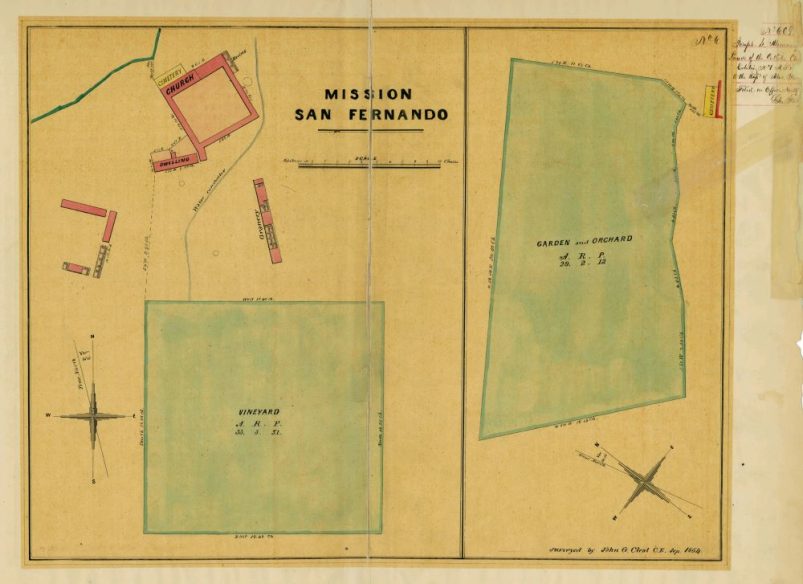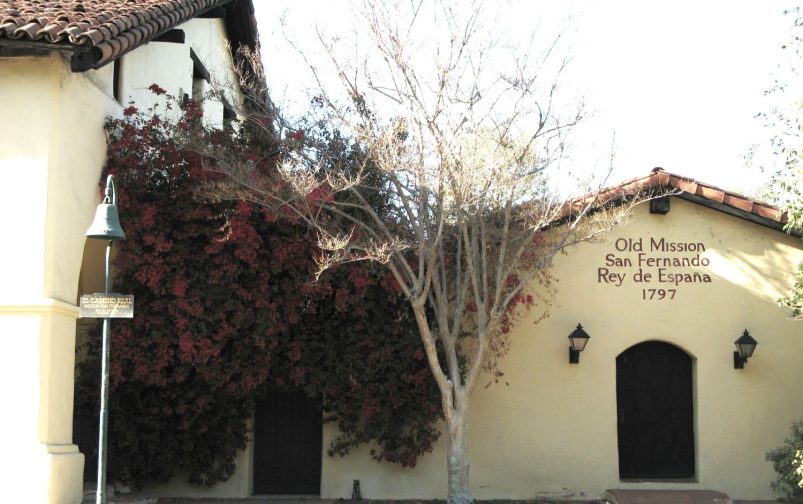Father Lasuén founded Mission San Fernando Rey de España on September 8, 1797. The Padres sought a location for a new mission to relieve the long journey between Mission San Gabriel and Mission San Buenaventura. Juan Francisco Reyes, the Alcalde (Mayor) of the Los Angeles Pueblo, had already claimed the most desirable location. He relinquished his claim, probably gracefully, was a patron at the formal dedication of San Fernando Rey de España Mission, and was godfather of the first child baptized.
Mission San Fernando was the fourth mission founded in three months as Father de Lasuén hurried to close the gaps in El Camino Real. A church was completed only two months after the dedication. With a ready market in the nearby Pueblo of Los Angeles, the mission started producing hides, tallow, soap, cloth and raising livestock; herds of the latter numbering in the thousands.
Nearness to Los Angeles produced another distinction for San Fernando. The wealthy mission became such a popular stopping place for travelers that the Padres added again and again to the Convento wing until the hospice became known as the famous “long building” of El Camino Real.

Unfortunately, the Indian neophyte population tended to decrease in direct proportion to the arrival of new European settlers. The time came when there were scarcely enough Native American workers to supply products demanded by the military nor make necessary repairs to the buildings after the earthquake of 1812. The resident Padre, Father Ibarra, refused to renounce allegiance to Spain, but the Mexican Government allowed him to remain, as there was none other to supervise the mission’s decline.
At last, the good Padre left of his own accord, unable to bear the hostility of the Civil Authorities. Governor Pío Pico leased the mission lands to his brother Andres in 1845. The hospice became the brother’s summer home. Further decline saw the church and hospice used as a warehouse and stable while the quadrangle became a hog farm.
The fortunes of old Mission San Fernando increased dramatically with public awareness of the historical significance of the chain of California missions. San Fernando became a church again in 1923. Since then the church, the “long building”, and the quadrangle have been restored. The hospice and Convento house an important museum, with a seminary, archives, and archdiocese headquarters on the grounds.
A prominent feature at San Fernando is the long Convento wing, which travelers used as a hospice, posada, or hotel during Spanish times when the Missions were a day’s ride apart on horseback. Across the street in Brand Park stands an old mission fountain and Barnham’s statue of Father Serra with his arm around an Indian boy. Today, the beautifully restored church and lovely mission gardens give no hint that, after the Secularization period, the buildings became used as a warehouse and stable, and the patio was a hog farm.
As recently as 1923, church officials returned to take up the restoration work. The years of neglect cleaned away, the great strength of the thick walls which withstood such careless treatment is now all the more evident. In the beautiful “long building”, the impressive wine press, smoke room, refectory, and Governor chamber for important personages are much as in former times.
